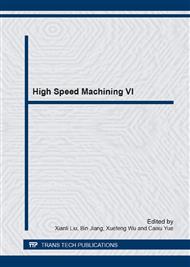[1]
Diamond tool materials for metal working, Element Six.
Google Scholar
[2]
Engineers Handbook Manufacturing Processes - Coatings Surface Finishing of CVD.
Google Scholar
[3]
www. cvd-diamond. com.
Google Scholar
[4]
The properties of CVD diamond, Element Six, (2009).
Google Scholar
[5]
Fleischer J, Deuchert M, Ruhs C, et al. (2008) Design and manufacturing of micro milling tools. Microsystem Technology14: 1771-1175.
DOI: 10.1007/s00542-008-0652-x
Google Scholar
[6]
Cheng Xiang, Wang Zhigang, Nakamoto Kazuo, etal. (2010) A study on the micro tooling for micro/nano milling. International Journal ofAdvanced Manufacture Technology doi: 10. 1007/s00170-010-2856-3.
Google Scholar
[7]
Fonda Peter, Katahira Kazutoshi, Kobayashi Yutaka, Yamazaki Kazuo. WEDM condition parameter optimization for PCD micro tool geometry fabrication process and quality improvement. International Journal of Advanced Manufacture Technology, DOI: 10. 1007/s00170- 012-3977-7.
DOI: 10.1007/s00170-012-3977-7
Google Scholar
[8]
David M Baker, Revolution in Diamond Cutting: Laser Sawing of Diamond Crystals.
Google Scholar
[9]
Uhlmann E, Schauer K. (2005) Dynamic load and strain analysis for the optimization of micro end mills. Annals of the CIRP 54: 75-78.
DOI: 10.1016/s0007-8506(07)60053-5
Google Scholar
[10]
Jin Masahiko, Goto Isamu, Watanabe Takeshi, et al. (2007) Development of cBN ball-nosed end mill with newly designed cutting edge. Journal of Materials Processing Technology 192–193: 48–54.
DOI: 10.1016/j.jmatprotec.2007.04.054
Google Scholar
[11]
Mamalis A.G., Horvath M., Grabchenko A.I. (2000) Diamond grinding of super-hard materials. Journal of Materials Processing Technology 97 : 120-125.
DOI: 10.1016/s0924-0136(99)00358-1
Google Scholar
[12]
Denkena B., Köhler J., Ventura C.E.H. (2014) Grinding of PCBN cutting inserts. International Journal of Refractory Metals and Hard Materials. 42 : 91–96.
DOI: 10.1016/j.ijrmhm.2013.08.007
Google Scholar
[13]
Tzeng C.J., Lin Y.H., Yang Y.K., Jeng M.C. (2009). Optimization of turning operations with multiple performance characteristics using the Taguchi method and Grey relational analysis. Journal of Materials Processing Technology 209 : 53–2759.
DOI: 10.1016/j.jmatprotec.2008.06.046
Google Scholar
[14]
Processing Technology 145: 84–92.
Google Scholar
[15]
E Uhlmann, K Schauer. Dynamic load and strain analysis for the optimization of micro end mills [J]. Annals of the CIRP, 2005, 54: 75-78.
DOI: 10.1016/s0007-8506(07)60053-5
Google Scholar
[16]
F. Z. Fang, H. Wu, X.D. Liu, et al. Tool geometry study in micromachining[J], Journal of micromechanics and microengineering, 2003, 13: 726–731.
DOI: 10.1088/0960-1317/13/5/327
Google Scholar
[17]
J Fleischer, M Deuchert, C Ruhs, et al. Design and manufacturing of micro milling tools [J]. Microsystem Technology, 2008, 14: 1771-1175.
DOI: 10.1007/s00542-008-0652-x
Google Scholar
[18]
C.D. Torres, P.J. Heaney, A.V. Sumant, M.A. Hamilton, R.W. Carpick, F.E. Pfefferkorn. Analyzing the performance of diamond-coated micro end mills [J]. International Journal of Machine Tools & Manufacture, 2009, 49: 599–612.
DOI: 10.1016/j.ijmachtools.2009.02.001
Google Scholar


